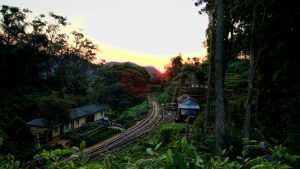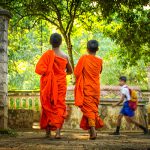Introduction
Wasgamuwa National Park has been an important center of ancient Sri Lankan culture but was ignored for several years. It is now slowly gaining popularity as more and more discerning travelers are seeking off-the-beaten-track holiday experiences.
Each boundary of the park has rivers, except the southern one. Also, the Sudukanda Mountain Range runs from north to south, in between the Amban Ganga (River) and the Mahaweli River. About 39,000 hectares in size, the park is adjoining the Riverine Nature reserve on the right banks of the Mahaweli River.
A visit to Wasgamuwa National Park is a tranquil escape into the wild, giving you the much-needed break from the everyday hustle-bustle that constantly revolves around your life. Driving through the most beautiful forests, engross yourself in the soothing sounds of nature and the scenic views around you. Keep your binoculars out for sightings of Sri Lankan elephants, sloth bears, birds, spotted deer, and more, as well as historical ruins that the park is known for.
Where is the Wasgamuwa National Park?
The park entrance is at Handunugamuwa and is best accessed from Kandy, Hasakala, and Hettipola. Wasgamuwa National Park is about 57kms from Kandy, approximately an hour’s drive. If you are traveling to the park from Matale and Polonnaruwa, you can route through Laggala and then Wilgamuwa, which is close to the National Park.
Climate and Weather
The average daily temperature at this National Park is about 28 Degrees Celsius and has a dry zone climate. Annual rainfall ranges between 1650 to 2100 mm during the months of July to September. The highest elevated point at Wasgamuwa is the Sudu Kanda (White Mountain), which is 470 meters high.
Historic Significance of the park
In 1907, the park was initially a game sanctuary and in 1938, it got upgraded to a Strict Nature Reserve. The Mahaweli Development Project deprived the wildlife of its habitat for some time but after that cleared, a neighboring piece of land was combined with the Wasgamuwa Park Strict Nature Reserve, and the entire unit was given National Park status in 1984 in an effort toward conserving biodiversity in Sri Lanka.
Historians have proved that this area was inhabited by men during the ancient Sihala Kingdom. The Giant Canal of Kalinga was built in the the12th Century when King Parakramabahu was in power, and the remains of four large tanks are witness that the area once prospered. Kalinga Island too is an interesting place to visit.
Kadurupitiya Dagoba, Buduruwayaya Buddha statue, Malagamuwa stone pillars, and other ruins also bear witness to the past glory of the area.
Yadanganapitiya is where the armies camped during the ancient battles and is yet another place of historical importance within the Wasgamuwa National Park.
Wasgamuwa National Park: The experience
Wasgamuwa National Park is home to a number of bird and animal populations which you will see when you go for a safari or game drive at the park.
There are 23 mammal species, 143 species of birds, 35 reptile species, 15 species of amphibians, 17 species of fish, and 52 species of butterflies at the Wasgamuwa National Park. The main attraction here is the high possibility of sighting large herds of elephants and the shy sloth bears. In addition to that, you may encounter leopards, water buffalos, wild boards, deer species, slender loris, golden jackals, and possibly the fishing cat. In addition to that, the park boasts a variety of bird species, of which eight of them including the Yellow-fronted Barbet, purple-faced langur, and the red-faced malkoha are endemic to Sri Lanka.
Large herds of about 50-100 elephants walking across the park can be seen if you visit during the peak season of November to May. During the other months of the year, these elephants migrate to Minneriya and Kaudulla National Park.
Marsh elephants are the largest species of Sri Lankan elephants, which are also seen at Wasgamuwa National Park. The park also boasts of having the highest bear population in comparison to other parks in Sri Lanka. the name “Wasgamuwa” is a reference to the Sinhalese phrase “was gamuwa” which when translated, means – the place where bears gather. Sloth bears are the species found in abundance at Wasgamuwa, believed to be the second-largest sloth bear population after block one of Yala National Park.
The vegetation here is tropical dry and the hilly ridges, as well as the river banks within the park, are covered in dense forests. While dense forests are a common characteristic of the park, extensive open plains in the east and southeast sections of the park are dominated by grass illuk. Trees such as the weera, wa and endemic kaluwara ebony are present in Wasgamuwa.
When should you visit the Wasgamuwa National Park?
The months of November to May are believed to be the best time to visit the Wasgamuwa National Park as the weather is pleasant and elephant sightings are also good during these months.
As for the safari, 6 am is better than the 3 pm drive because, in the morning, you will be able to hear birds chirping in the evergreen forests and see animals walking around in search of food.
Things to carry to the park
- Wear suitable clothing to keep you cool and comfortable
- Cameras with special lenses if required
- Binoculars
- Snacks and drinks
- Mosquito repellent
- Sunscreen
Things to do at the park
If you love photography, Wasgamuwa National Park is a paradise for captures of nature and wildlife. As you drive through the forest, you will see miniature versions of water pools where pythons, crocodiles, and other reptiles slither around while aquatic birds bathe there. While you are capturing nature at its best, make sure you don’t use flash on the animals and remain quiet so as to not disturb them in their natural habitat. In fact, you will lose sight of them if you disturb them as many animals will escape into dense forests at the sight and sound of humans. Don’t forget to capture elephant groups chewing on fresh grass and lounging in open areas – a sight saw during the morning hours as the afternoon is nap time for them.
Wasgamuwa National Park is not just known for its wildlife, it also has a rich culture and heritage. From as far back as the 2nd Century AD, the Buduruwayaya ruins are located southwest of the park. These ruins are a group of 1800-year-old Buddhist Temples and include a reclining statue of Lord Buddha and some stone pillars. More 2nd Century ruins have been discovered in other areas of the park as well. Another reclining Buddha statue is seen resting in the midst of greenery, at the meeting point of River Amban and River Kalu.
If you want to explore the wilderness of Wasgamuwa National Park in Sri Lanka in more detail, we suggest you camp inside the park for about two nights. Standard camping tents are set up where you can meet other wildlife explorers and enjoy barbeque dinners while you converse with them under beautiful starry nights.
Accommodation
If you are looking for an insider experience, you can either opt for one of the five campsites around the National Park or you can choose to stay in one of the three bungalows located within the park. For hotel accommodation, the closest you can find to Wasgamuwa is just north of Kandy. In this case, your day will have to start really early for morning safaris. Although the park is off the tourist track, it comes with its own set of advantages, a significant one being that you will have the park mostly to yourselves.
The post-Wasgamuwa National Park appeared first on Blue Lanka.



